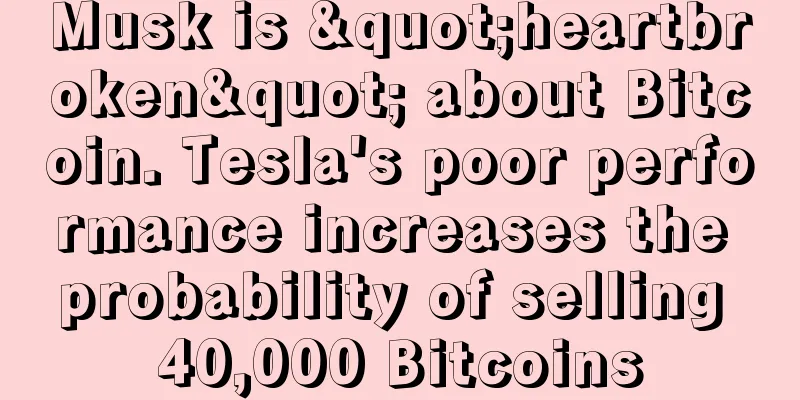Liu Jibin: Closed-loop mining, a must-have for capital to enter the market

|
Obviously, capital is the umbrella and booster for miners' "mining", especially in the current "mining 2.0" era. One thing that needs to be explained is that the "capital" I mentioned in this article and the previous article is a narrow concept of capital, referring only to direct investment by public companies with strong direct financing capabilities. Compared with private equity, direct investment by listed companies will face more information disclosure and stricter restrictions on business compliance requirements, but once the business introduction is completed, it will fully demonstrate its strong fundraising ability and risk resistance, and the controllability of business decisions will be stronger. However, even with the blessing of capital, "mining" is not a "lying win" that can be achieved overnight. On the contrary, due to the above-mentioned distinctive characteristics of capital, "capitalized mining" also needs to pay more attention to "posture". Only the most suitable mining "posture" can maximize the advantages of capital and obtain tenfold or a hundredfold bonus effects for participants. From a certain perspective, the involvement of capital is actually an integration process of assetizing, capitalizing, and securitizing "mining" business resources. In this process, the sustainability and replicability of the solution, as well as the solution to extreme market conditions, will be further emphasized. Therefore, for "capitalized mining", the closed-loop "mining" model of high-quality self-owned mines + self-owned mining machines of equal load volume + redundant capital plan is obviously a more stable, lasting and imaginative business model. High-quality self-owned mines, consolidating business foundation through "resource assetization"The mining farm provides the basic operating environment for the "mining" business. Although the mining farm assets are far from comparable to the mining machine assets in terms of investment proportion, they are the ultimate risk in the "mining" business logic: if there is unstable power supply, non-compliant qualifications or even human misconduct at the mining farm end, even the most accurate "mining" strategy model will be ruthlessly "exposed". Therefore, owning a high-quality mining farm is the foundation and guarantee for the security of project assets and even the establishment of a closed-loop "mining" business model. To be more precise, a mine is more of a resource than an asset. It is a reflection of the mine's ability to coordinate and control power supply resources. Without power supply capacity, the so-called mine assets will be worthless. Therefore, the "mine" logic is a very special existence in the mining circle. Only by closely combining power supply capacity and physical entities can we form stable asset attributes. The reason why I add two prefixes to the "mine" to modify the "high-quality self-owned mine" is that they are extremely important and easily overlooked: "self-owned" reflects the control of the "mining" business entity, while "high-quality" reflects the real use value of the mine. In comparison, "high-quality" is more important and more difficult to evaluate than "self-owned". The former is also the premise of the latter. If capital touches and accepts low-quality mine assets, it is like shooting itself in the foot. It will only have a counterproductive negative effect on the improvement of its business model and the establishment of investor confidence. So, what is considered a "high-quality mine"? Or what are the criteria for judging whether a mine is "high-quality"? First, the credibility and communication and coordination ability of the mine initiating team (government side, power grid side, power generation side); second, the form of power supply and electricity price structure; third, the power supply cost; and finally, the construction standard. Many investors or custodian customers use construction standards or even construction aesthetics as the criteria for judging the quality of a mine. This is putting the cart before the horse, and simply considering the cost of electricity is a way of judging with great hidden dangers. In addition, from the comparison between thermal power mines and hydropower mines, it should be said that each has its own advantages and disadvantages. In comparison, hydropower mines have stronger resources and higher thresholds, and will emphasize the first-mover advantage of local water resources and the professionalism of the operation team. Due to limited space, I will only say a few words on this topic. If friends are interested in the future, I will write a separate article to give you a more in-depth introduction and analysis. Mining machine asset allocation, grasp the "three quantities" principleThere is no doubt that mining machines are the most "hard" assets in the "mining" business logic. They are so hard that people in the industry have always used the number of P computing power mining machines they own or control as a symbol of strength. In the logic of "closed-loop mining", mining machine assets are still a killer, but they emphasize relaxation and tension. Specifically, it is to grasp the "three quantities" principle of "teaching according to aptitude, tailoring according to needs, and doing what one can". The "material" in "teaching students according to their material" refers to the characteristics of various supporting and auxiliary factors in the mining business (except mining machine assets), such as the type of mine, the stability of power supply, the asset amortization and income accounting model, the nature and redundancy of operating funds, etc. In fact, it is to formulate a mining machine asset allocation plan according to local conditions in order to achieve the best capital utilization and return on investment. For example, a few days ago, 500.com, a US-listed company, announced that it had purchased a batch of Bitcoin mining machines through additional issuance, and clearly stated that they were mainly mid-range models such as m20s, m21s, and t17, and even included a large number of low-end machines such as s9 and t2. Many investors and friends in the circle were confused about this operation. In fact, everyone knows that the lower the power consumption ratio of the mining machine model, the longer the payback period. According to the current anchored coin price and the computing power of the entire network, the payback period of the current "king machine" s19pro and m30s is as high as 1 year, and the payback period of mid-range machines such as m20 and s17 has been shortened to about half a year, while the payback period of mainstream low-end machines such as s9 and t2 is only 55-70 days. Miners are well aware of the above cost advantages of low-end machines (models with high power consumption ratios), but what deters them is the relatively weak risk resistance of low-end machines: once the price of coins drops sharply, low-end machines will more easily reach the "shutdown line" of the profit critical point, and there is a possibility of losing all their money. The 500.com system has the most stable, largest, and most fully qualified hydropower mining farms in China. The unique pricing mechanism of hydropower mining farms has greatly lowered the shutdown risk line of mid- and low-end models; in addition, 500.com has always had a very abundant cash flow capacity, which has become another favorable guarantee to resist the periodic plunge in coin prices. It can be said that the high-quality and stable hydropower mining farms and sufficient funds available for allocation have given 500.com the confidence to take advantage of the situation. The planned allocation of some mid- and low-end mining machine assets can greatly shorten the payback period and increase the investment payback rate. At the same time, it also solidifies the mining farm-side income at a relatively low cost, which is actually a remarkable differentiation strategy. On the contrary, if you just follow the rules and aim high, it is not closed-loop mining, it is called closed-door development. "Tailoring" means emphasizing the equal matching of mining machine assets and mining farm assets. Although it belongs to the tactical level, it has played an increasingly important role in improving asset utilization and asset preservation, especially for capital entities with a large number of mining machine assets. If the equal matching of mining machine and mining farm assets is not handled well, especially in the extraordinary period when the supply and demand relationship at the mining farm end changes suddenly, it is easy to choose unreliable mining farms because of the worry that the mining machine assets in hand will be idle. Once you fall into the pit, at best you will get half the result with twice the effort, and at worst (mining machine assets) will be "a drop in the ocean". Of course, the equal matching I mentioned is just a logical direction, not a requirement for equal or exact equal matching at all times. It is unrealistic and unnecessary to be too demanding. "Do what you can" is from the perspective of the balance between mining machine asset allocation and capital utilization. In fact, it is the same topic as the "redundant capital plan" mentioned at the beginning, because mining machine asset allocation is the most expensive link in the "mining" business logic. Let's put the two together. In the past, many miners may have been based on their belief in Bitcoin, and often "all in" to enter the market, fearing that they would miss the opportunity to make money. On the surface, they have improved the utilization rate of funds, but in fact, they are overdrawing their own capital allocation capabilities, that is, reducing their ability to resist the risk of a sharp drop in the price of the currency. On the one hand, we agree with the long-term upward trend of BTC, and on the other hand, we must fully foresee its volatility, and the amplitude and cycle of this volatility are likely to be more intense and longer than most people think. The strategy of "exchanging money in a bull market and hoarding coins in a bear market" is easy to understand. The key is whether you can maintain a good mentality and "leave some". If you experience a test similar to "3.12" again, you will not be able to survive the "winter" of the currency price without enough "food reserves". The lighter ones will easily stop "coins" to survive, and the heavier ones will only die from "gold". Redundancy plan and capital supportThe redundant funding plan I mentioned does not refer only to the cash flow that has been "lying" on the books, but the depth of funds that can be deployed in the continuous payment cycle of electricity bills. To put it more bluntly, it is how long you can bear not to sell coins to pay electricity bills. Specifically, I think the emergency "blood supply" capacity from April to June is a more reasonable funding plan. If it is mainly low-end and mid-end models (power consumption is more than 60w/t), it is more appropriate to expand the redundant plan to August-December. At the same time, it is not ruled out that high-level hedging products such as shark fins and other currency-based hedging products can be used as auxiliary. Financial institutions such as PayPal and GSR that are deeply involved in the mining circle have relatively mature solutions. For capital, further improving profit indicators in a business cycle is far less important than strengthening the sustainability of cyclical profits. Investors are more willing to use some visible short-term benefits to replace more stable business models. Of course, capital is not only making demands for the stability of the "mining" business model, but will also play an increasingly important practical role as the degree of participation deepens: in addition to the unique secondary market fundraising ability, the mining machine and mine farm assets after asset capitalization and capital securitization can be applied to more effective, more lasting and more convenient financing and lending methods, thereby making the "mining" business more orderly and easy to operate. It can be expected that capital and mining will enter a "honeymoon" stage of mutual achievement. |
<<: The fuse of the bull market has been completely ignited
>>: Report: Cryptocurrency crime rate fell 57% in 2020, but DeFi hacking incidents surged
Recommend
Emotions are in a frenzy, don’t take risks lightly
Madman said Madman believes that people can be di...
1BTC can buy 1.5T computing power, with an annualized return of 25%! PACMIC Cloud Mining V3 is online
On August 12, 2015, Beijing time, Bitmain's B...
The 12 most common palmistry features that indicate wealth and prosperity
In modern society, everyone hopes to be extremely...
How to see the position and fate of shoulder moles
As the saying goes, shoulders carry the weight of...
Li Qiyuan's talk about SegWit2x caused huge controversy, and the founder of "Latiao" refuted that BTC is not a competing currency
On Wednesday, BTCC CEO Bobby Lee discussed his vi...
Hexagram 13 - Heaven Fire Tong Ren (Tong Ren) - Harmony between upper and lower parts - Middle Upper Hexagram
Heaven moves with vigor, and a gentleman should c...
Palmistry: Are there more noble people or villains around you?
Palmistry: Are there more noble people or villain...
Visa and Chain join forces to build blockchain remittance network
Rage Comment : Visa, an international traditional...
Payments giant PayPal is hiring crypto talent in Ireland
Global payments giant PayPal is hiring for severa...
What animal do you like?
There are cute animals, domineering animals, and ...
What is sovereign digital currency? What is its role and value?
Bitcoin was born from the ideals of anarchists, a...
Hiding wealth and safe haven funds
Chapter 0 Introduction Big news came out today - ...
How to tell fortune from face? How to tell fortune from face
Physiognomy has a long history in our country, an...
What does it mean to have a mole on the nasolabial folds?
What does it mean to have a mole on the nasolabia...
Moles on the face determine a person's health fortune
Moles on the face determine a person's health...









